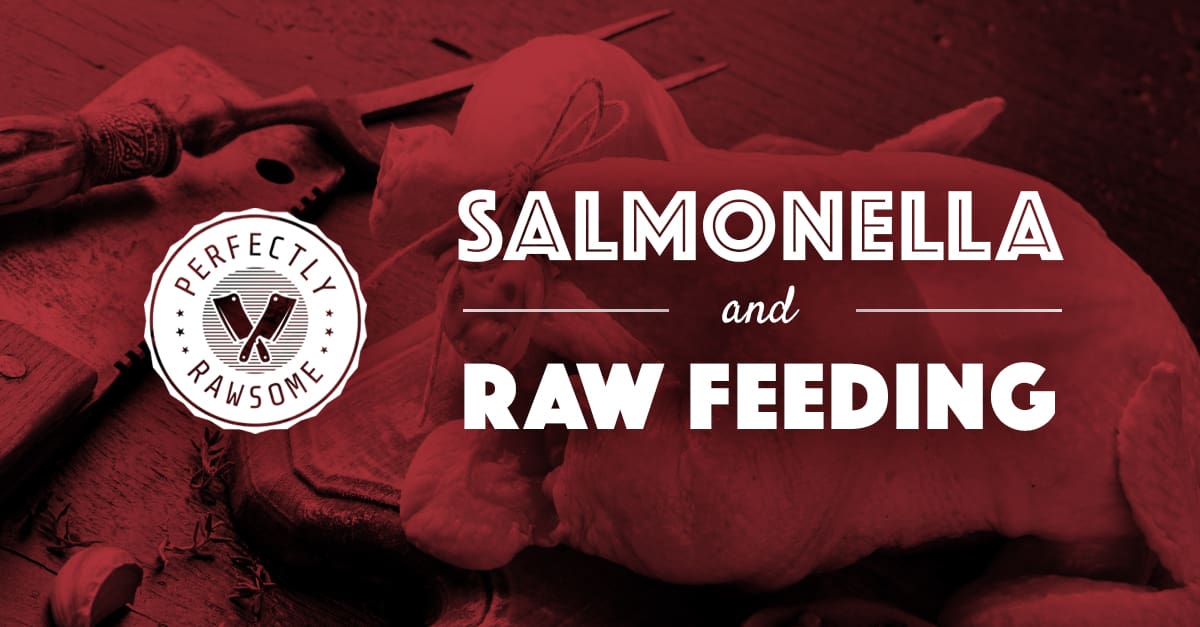Many pet parents and veterinarians initial objection to raw feeding is the concern that they or their pet might get sick from harmful pathogens. Recalls on raw meats lead pet parents to wonder “Is my pet at risk of getting Salmonella from raw meat? or “Is my family at risk of getting Salmonella from raw feeding?” However, it is important to know that Salmonella is a naturally occurring bacteria.
Regulatory bodies such as the Food and Drug Administration (FDA) issue recalls on raw meat. Many of these recalls cause concern among pet parents. However, it is important to have a full understanding of Salmonella and the digestive system of carnivores such as dogs and cats.
What is Salmonella?
"Salmonella" is a term for multiple strains of salmonella bacteria and only a few are pathogenic.
Food Safety Practices
Standard food safety practices are needed when handling raw meat.
The Carnivore's Digestive System
Salmonella poses minimal risk to healthy dogs and cats.
Salmonella is more of an issue for humans than it is for carnivorous pets. This is not to say that appropriate food handling and safety should not be used when preparing raw diets. As long as safe food sourcing and handling practices are followed, salmonella is not a major concern for illness in healthy dogs and cats.

What is Salmonella?
There are two species of Salmonella (Salmonella enterica and Salmonella bongori) and there are multiple sub species (enterica, salamae, arizonae, diarizonae, houtenae, indica, bongori). These species include more than 2,600 serotypes.
Many of the sub species of salmonella are commonly found in cold-blooded animals and in the environment. The sub species enterica is commonly found in warm bodied animals. There following are the main groups of Salmonella serotypes found within warm bodied animals:
Salmonella serotype, Typhoidal
Typhoidal serotypes are adapted to humans and do not occur in other animals.
Salmonella serotype, Non-typhoidalserotypes
Can be transferred between humans and other animals.
According to the Center for Disease Control and Prevention (CDC), Salmonella is a bacteria that infects the intestinal tract and causes extreme sickness in humans. The illness people get from a Salmonella infection is called salmonellosis. Salmonellosis can last 4 to 7 days with symptoms appearing 12 to 72 hours after infection. Most people recover without medical treatment. However, salmonellosis can lead to hospitalization due to dehydration or an infection in the bloodstream. In some cases, Salmonella can lead to death.
The CDC estimates Salmonella causes about 1.2 million illnesses, 23,000 hospitalizations, and 450 deaths in humans in the United States every year. The majority of these cases are linked to contaminated food sources.
Pathogenic Bacteria
Our entire world is populated with bacteria including our bodies. According to the National Academy of Sciences of the U.S.A., there are as many as 1 trillion different types of bacteria. Most strands of bacteria are harmless and even beneficial! The term “bacteria” and “salmonella” has become buzz words in marketing as methods for click bait articles and sensationalized articles.
However, this is not to say that salmonella poisoning is not real – it is important to differentiate between pathogenic and non-pathogenic bacteria. Pathogenic bacteria are the bacteria that can cause diseases. These bacteria produce different effects with humans and animals. They attack host cells within the organism and produce various symptoms. Pathogenic bacteria can be reduced with sterilization, disinfectants, and cooking food to temperatures above 73 °C (163 °F).
Food Safety
For those who are concerned that they or their family members could become ill from Salmonella when raw feeding, an additional question is asked in response:
“Do you prepare raw meat to cook for yourself and your family?”
The answer is usually “Yes” unless the person is a vegetarian or vegan. The same safe food handling practices that are used when preparing raw meat for human meals should be followed when raw feeding. According to FoodSafety.gov and the CDC, there are four methods of food safety when cooking in the home – clean, separate, cook, and, chill. It is also worth noting that even humans consume some raw meats such as sushi, tartare and carpaccio.
Due to their tendency to consume feces or similar items and groom private areas, pets are carriers of bacteria regardless of the diet they are fed. Setting limitations on allowing the pet to lick family members should be considered if contamination from a pet is a significant concern for children or immune-compromised individuals. However, recent data shows there is a Low Number of Owner-Reported Suspected Transmission of Foodborne Pathogens From Raw Meat-Based Diets Fed to Dogs and Cats.
This article will focus on clean, separate, and chill in relation to food safety and handling when feeding pets a raw diet.
For more information about Salmonella prevention, please visit the Center for Disease Control and Prevention’s website.
The Carnivore’s Digestive Tract
Dogs and cats will be a host of Salmonella bacteria regardless of the diet they consume. Pets are natural hosts for a wide range of Salmonella species and humans are more likely to become sick from Salmonella than pets.
“But there have been recalls on raw dog and cat food due to Salmonella!”
That is correct. However, those recalls have primarily been for the safety of the humans handling the food. The concern is for the human, not the dog or cat. The food safety protocols for raw meat discussed previously should still be applied to commercial raw pet food. It is also important to note that recalls for Salmonella have occurred with dry and canned pet food as well. With this in mind, sanitary practices should be applied to all pet food whether it is raw or not.
A dog’s and cat’s digestive system has a unique way of preventing and fighting against pathogenic bacteria such as Salmonella. There are two main factors – the stomach’s pH level and the incubation period of Salmonella. Pet parents often observe these factors at work when their pet remains healthy regardless of the pet’s dietary indiscretions, such as consuming feces or rotten carcasses.
Stomach pH
The hydrochloric acid in a dog’s and cat’s stomach has a pH level of 1 to 2. Salmonella can only survive in a pH range of 3.8 to 9.5. The acidity of a dog’s and cat’s stomach is a protective measure against ingested pathogens and is not conducive to the growth of Salmonella.
Digestive Tract
The average amount of time it takes a dog to fully digest and eliminate waste is 6 to 8 hours. A cat’s digestive tract is even shorter! The incubation period of Salmonella is 8 to 72 hours. Within this time, the dog or cat has completed the digestive process and any remaining Salmonella that may have survived digestion is passed in the feces.
This isn’t to say that it is impossible for a dog or cat to become sick from pathogenic Salmonella. However, healthy dogs and cats should have the necessary tools to prevent salmonellosis. If a dog or cat has a compromised immune system it is possible they could contract Salmonella. The chances are small and salmonellosis is rare when a healthy gut flora is maintained.
Healthy Digestive System
Supporting the digestive system and gut flora helps to promote healthy immune function. An estimated 70% to 80% of immune cells are located in the digestive tract. Beneficial bacteria found within the colon is an additional protective measure against ingested pathogens. A balanced diet of raw, fresh foods is a major component to building and supporting a healthy intestinal microbiome.
Probiotics also support the colonization of healthy bacteria in the colon and help fight against pathogenic Salmonella. Probiotics can be provided in a few different ways. This includes feeding fermented vegetables, kefir, or commercial probiotic supplements.
Fiber is another key factor in promoting a healthy digestive system. Fiber resists enzymatic digestion in the small intestine and is fermented in the colon by beneficial bacteria. Short-Chain Fatty Acids (SCFAs) are produced as a byproduct of fiber fermentation and provide the colon wall with energy. Fiber is easily available in green leafy vegetables, berries, and fur/feathers from whole prey.
CLOSING COMMENTS
Bacteria is everywhere. Fresh food is not sterile and will contain bacteria just like there are bacteria that make up every human’s digestive tract. The important take away is to understand the difference between harmless, beneficial, and harmful bacteria.
Additionally, always remember to follow basic food handling safety guidelines and feed fresh foods to support a healthy immune system. Dogs, cats, and humans alike can contract illness from Salmonella-contaminated foods. However, it is important to remember that a dog or cat with a healthy immune system has an extremely low chance of becoming sick from Salmonella.
